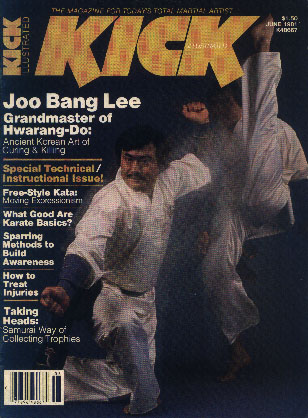
(Kick Illustrated - June, 1981 Issue)

While most martial arts focus on the craft of maiming and killing,
few propogate the techniques of healing. Dr. Joo Bang Lee's Hwa Rang Do is a
complimentary mixture of the combative and curative. Experts employing this
complex ancient Korean art can incapacitate an antagonist as surely as they
can revive him.
The martial artsman should continually strive to be one with the laws of nature,
a living example of the dichotomies of Yin and Yang, by unifying the body, mind,
and spirit into a single force capable of doing anything he so desires. In the
physical realm, a well-rounded martial artist should have the working knowledge
of tense, linear-oriented techniques which use distance and precise angles (Yang)
as well as soft, circular-oriented techniques that stress closeness and flowing
movement (Um) as a basis of attack and defense. He must also combine
the physical aspects with the mental applications of alertness, strategy, and
a general display of mental discipline with the spiritual manifestations of
both. 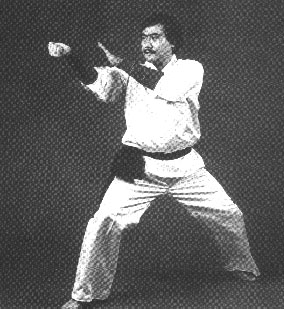
By understanding and utilizing these aspects of Um and Yang, the martial artist
combines his thoughts and actions into a cohesive, natural fighting system.
In order to achieve a balance, however, a martial artist who has the capabilities
to cause both injury and death to another human being must possess the facility
to heal as well. Without this balancing element, the martial artist can never
be one with the order of the universe. Therefore, at more advanced levels in
the esoteric martial art/healing art of Hwa Rang Do, the student must learn
the oriental healing arts in conjunction with the fighting aspects; for since
he knows how to kill, he must know how to cure. 
The practitioner of Hwa Rang Do must be fully versed in the basics of human
anatomy, structure, function, and physiology. The human body is composed of
both extremely strong, durable components as well as weak points. By knowing
these various vital points, correct applications of precise strikes can make
an excellent defense or offense for even the most diminutive person. Use of
specific angles, in conjuction with certain methods of application directed
to the articulating joints, can subdue even the strongest assailant with minimal
effort. All strikes are directed to specific points for a predetermined outcome
of the application; thus enabling the practitioner to contain and control his
adversary to whatever degree the situation dictates.
The finger pressure techniques simply require memorization of the points involved,
supplemented with the proper method of application. Yet, due to the potential
lethality of certain points, they are generally taught only at advanced levels
- when the student has proven without doubt that he will not abuse his knowledge
- and as defensive techniques for handicapped individuals or senior citizens.
The joint-manipulation techniques of Hwa Rang Do are based on a combination
of knowledge of human physiology and the laws of physics, especially as it peratins
to angles and leverage. Just as a stone weighing one ton might take 10 men to
move it (or one man with a lever and fulcrum), the manipulation and/or breaking
of joints can require a great deal of physical effort - or the proper angle
and method of utilization.
These methods of offensive and defensive applications can be referred to as
"Gentlemen's Self-Defense" - wherein minimal effort is needed to contain
and control an opponent; yet one in which the assailant is subdued within one
movement, and is unequivocably controlled at the discretion of the "gentleman"
initially attacked. These same laws of physics may be applied in the execution
of any hand strike, kick, or throw - combined with the practical knowledge of
where to strike for maximum effect. 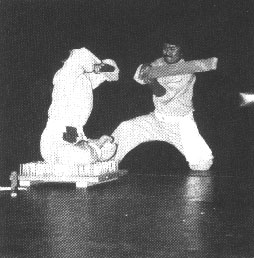
Due to the comprehensive nature of this martial art, Hwa Rang Do's moo sul techniques
can be subdivided into numerous categories and class types, all dependent on
the specific needs of the individual or group. Under the auspices of the World
Hwa Rang Do Association, specialized courses are conducted for the specific
needs of various groups, i.e., training programs for special military forces
are conducted specifically for their combative needs; programs are available
for law enforcement personnel that deal exclusively with their special problems;
classes are designed for the specific needs of women's self-defense; as well
as specialized classes for senior citizens emphasizing finger pressure points,
joint manipulation, and cane techniques. Courses are also available for the
physically handicapped, with each technique taught being specifically designed
for each individual.
Although Hwa Rang Do is a combative martial art, some techniques can be modified
to allow those students so inclined to participate in light-contact or full-contact
tournament fighting. In fact, in inter-school Hwa Rang Do competitions, the
point system is different from many conventional tournaments in that points
are given for hand strikes, kicks, throws and takedowns, and joint-breaking
and choking techniques, with an aggregate of points accumulating over a specific
period of time.
Specialized courses involving weaponry are also available, as well as those
dealing primarily in yoga and meditation. Special classes are taught for children
which emphasize the code of ethics inherent to the art of Hwa Rang Do: Loyalty
to one's country; loyalty to one's parents and teachers; trust and brotherhood
among friends; courage to retreat in the face of the enemy; justice never to
take a life without cause. This ethical code of behavior embraces humanity,
justice, courtesy, wisdom, trust, goodness, loyalty, virtue, and courage.
These and more specialized programs are taught in conjunction with the standard
classes in which the entire repetoire of Hwa Rang Do techniques are taught,
thus combining these various aspects. Specialized instructor courses are available
to advanced students who wish to become professional martial artists, as well
as intensive seminars held on a periodic basis, both at present school locations
and at the invitation of interested parties. These seminars generally encompass
the various martial art applications in addition to ceratin aspects of the healing
arts. 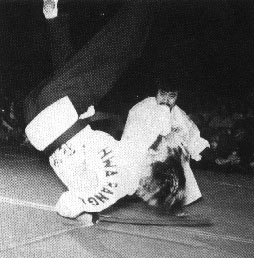
The in sul aspect of Hwa Rang Do deals with the study of Oriental healing
arts of acupuncture, acupressure, herbal and natural medicines, and bone setting.
The World Hwa Rang Do Association's affliated Dong Kook Acupuncture College
in Downey, California, deals with these applications for both professional physicians
and interested laymen.
In order to study the field of acupuncture, one must be completely familiar
with its basic concepts and ideologies - that of energy flow or ki. In the study
of occidental medicine, the student must be completely familiar with the intricacies
of the various systems of the body: the muscular system, circulatory system,
skeletal system, digestive system, nervous system, respiratory system, and so
on, and how they interrelate with one another.
The occidental medical mind is extremely analytical towards what can be physically
seen (to the aided and unaided eye). In oriental medicine, the approach is somewhat
different. Of course, all the above systems of the body must be thoroughly known.
But there is an additional system that is not studied in traditional occidental
medicine because, to date, it cannot be visibly seen. This is ki, the
energy system which courses through the body in specific pathways called meridians,
of which there are 26.
In oriental medical thought, it is believed that man is an exact replica of
nature and the universe, and is therefore intricately connected with its natural
governing laws. The universe consists of five elements: Wood, fire, water, metal,
and earth, plus one additional element that cannot be seen - air. The universe
also contains both positive and negative forces (Um and Yang, Moon/Sun, Female,
Male, etc.).
The meridians of the body correspond to the 12 months of the year. Because the
body is symmetrical, there are 12 meridians located on each half, totaling 24,
plus one running up the back (governing meridian-Yang) and another running down
the front (conception meridian-Um). On these symmetrical meridians lie 365 vital
points (corresponding to 365 days in a year), with approximately 150 extra "body"
points, bringing the total to over 500 vital points found on the body.
In medical practice, it is thought that if the body is injured, diseased, or
has fallen ill, it is out of balance with its natural order. Therefore, in order
to rectify the 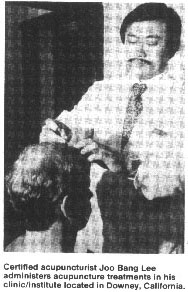 natural
balance, it must be re-achieved. By stimulating the vital points in a specific
manner, one can alter the energy flow to the various organs of the body, thus
acting upon the primal root of the problem, not the symptom, which enables the
practitioner to cure his patient. As with any complex endeavor, one can devote
an entire lifetime to the study of this 5,000-year-old healing art, in conjunction
with the studies of moxibustion and herbal medicines. When the technology of
occidental medical procedures, truly remarkable healing applications will be
found.
natural
balance, it must be re-achieved. By stimulating the vital points in a specific
manner, one can alter the energy flow to the various organs of the body, thus
acting upon the primal root of the problem, not the symptom, which enables the
practitioner to cure his patient. As with any complex endeavor, one can devote
an entire lifetime to the study of this 5,000-year-old healing art, in conjunction
with the studies of moxibustion and herbal medicines. When the technology of
occidental medical procedures, truly remarkable healing applications will be
found.
One first aid technique of in sul which is especially apropos to martial artists
concerns itself with the treatment of someone who has fainted, been knocked
out, or otherwise lost consciousness. Simply extend the middle joint of your
middle finger and apply a firm pressure to the in jung point (that vital point
located at the base of the nose (between the nostrils) and vibrate your hand
circulary on this point. This action alone should cause the victim to regain
consciousness. It has an effect similar to smelling salts.
This is one example of acupressure technique called Hwang Ga Hyel Do Ji Ahp
Sul (meaning "Royal Family Finger Acupuncture"). In ancient
times, members of the royalty of the kingdom of Silla used this form of acupressure
to effectively heal minor aches and pains, and to recharge and revitalize themselves.
Today this form of acupressure is taught and applied at the Dong Kook Acupuncture
College, under the auspices and direction of its president, Dr. Joo Bang Lee,
O.M.D.,C.A., PhD. In addition to the courses taught, Dr. Lee operates an acupuncture/acupressure
clinic/spa which is open to the general public.
Readers interested in learning more about the martial art/healing art of Hwa
Rang Do are invited to contact the:
Hwa Rang Do® World Headquarters
13762 Newport Ave. #201 Tustin, CA 92780
(714) 731-5425 (KICK)